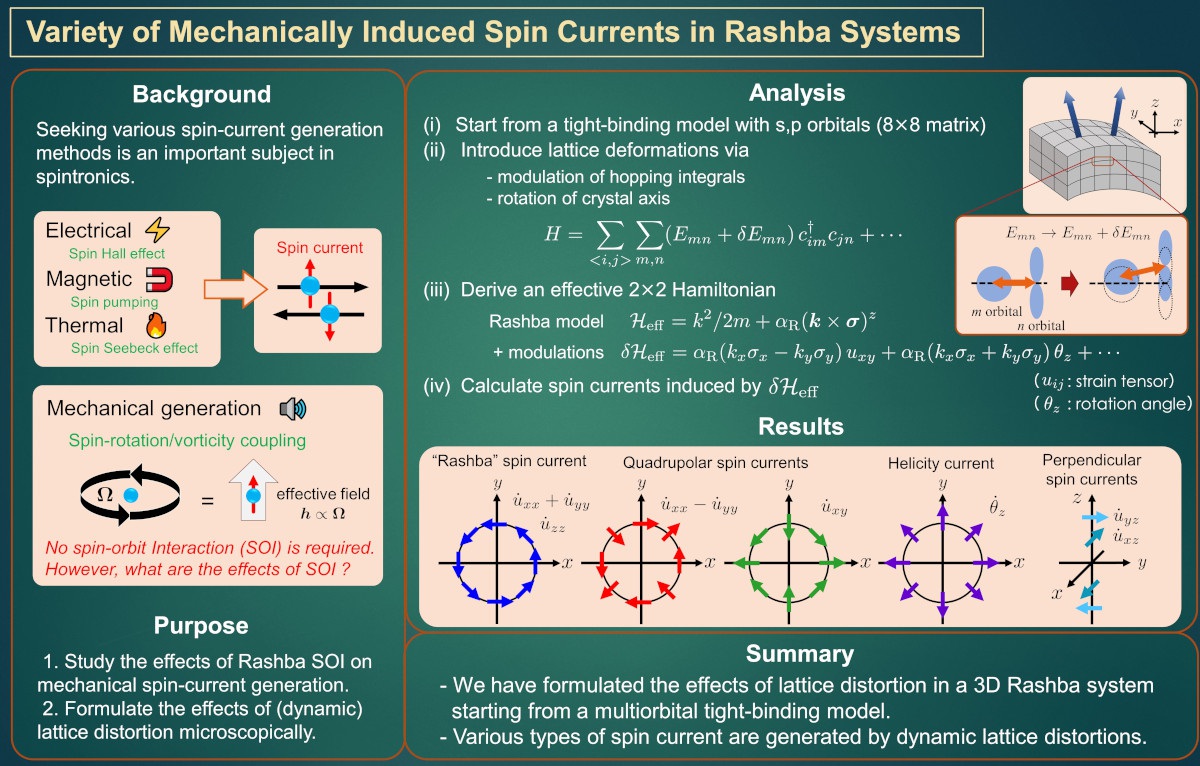Variety of Mechanically Induced Spin Currents in Rashba Systems
© The Physical Society of Japan
This article is on
Microscopic Analysis of Lattice Distortion Effects in Rashba Systems
J. Phys. Soc. Jpn. 92, 113702 (2023).
Various types of spin currents, including unconventional types, are generated in Rashba spin-orbit coupled systems by dynamic lattice distortions associated with, for example, surface acoustic waves.

Spin current, the flow of spin angular momentum, is a central element in spintronics for future technological applications. Thus, elucidating various mechanisms to generate spin currents is an important topic. Since the discovery of the gyromagnetic effect more than 100 years ago by Einstein, de Haas, and Barnett, spin angular momentum has been known to be mutually converted with the mechanical angular momentum associated with rotational motion of materials. This suggests that spin currents can be generated mechanically. Present-day experiments have shown that spin currents are generated by shear flows in liquid metals and by surface acoustic waves in solids.
The electron spin also interacts with its orbital motion through relativistic effects, that is, the spin-orbit interaction (SOI). The SOI is responsible for various spin-current generation methods because it bends the electron orbits in spin-dependent directions. In particular, the Rashba SOI appears in systems with broken spatial inversion symmetries, such as at the surfaces and interfaces of materials. When generating spin currents using surface acoustic waves, the effects of Rashba SOI may be utilized.
In this study, we investigated spin-current generation from dynamic lattice distortions in systems with Rashba SOI. Unlike prior theoretical studies, we started from a multiorbital tight-binding model to derive a Rashba model perturbed by lattice distortions. This method enabled us to treat the lattice distortion effects microscopically through the modulation of hopping integrals and local rotation of the crystal axes. By calculating the linear response to the effective perturbations, we observed that surface acoustic waves can generate a variety of spin currents through the Rashba SOI, including unconventional spin currents, such as the quadrupolar spin current, perpendicular spin current, and helicity current.
Written by Y. Ogawa on behalf of all authors.
Microscopic Analysis of Lattice Distortion Effects in Rashba Systems
J. Phys. Soc. Jpn. 92, 113702 (2023).
Share this topic
Fields
Related Articles
-
Electricity Provides Cooling
Magnetic properties in condensed matter
Structure and mechanical and thermal properties in condensed matter
Cross-disciplinary physics and related areas of science and technology
2024-10-15
Electric cooling at low temperatures is successfully achieved using a ferroelectric ferromagnetic solid instead of refrigerant gases such as fluorocarbons.
-
Pressure-Tuned Classical–Quantum Crossover in Magnetic Field-Induced Quantum Phase Transitions of a Triangular-Lattice Antiferromagnet
Magnetic properties in condensed matter
Electron states in condensed matter
Cross-disciplinary physics and related areas of science and technology
2024-9-5
The correspondence principle states that as quantum numbers approach infinity, the nature of a system described by quantum mechanics should match that described by classical mechanics. Quantum phenomena, such as quantum superposition and quantum correlation, generally become unobservable when a system approaches this regime. Conversely, as quantum numbers decrease, classical descriptions give way to observable quantum effects. The external approach to classical–quantum crossover has attracted research interest. This study aims to demonstrate a method for achieving such control in materials.
-
Discovery of Light-Induced Mirror Symmetry Breaking
Dielectric, optical, and other properties in condensed matter
Electronic transport in condensed matter
2024-9-2
The authors discovered the light-induced mirror symmetry breaking, paving the way for controlling mirror symmetries via light and for realizing various phenomena utilizing the mirror symmetry breaking.
-
Discovery of Unconventional Pressure-Induced Superconductivity in CrAs
Superconductivity
Electronic transport in condensed matter
2024-8-13
A new study has discovered pressure-induced superconductivity in the helimagnet CrAs, originating in the vicinity of the helimagnetic ordering, representing the first example of superconductivity in Cr-based magnetic systems.
-
Unification of Spin Helicity in the Magnetic Skyrmion Lattice of EuNiGe3
Magnetic properties in condensed matter
2024-8-7
In the magnetic skyrmion lattice of non-centrosymmetric EuNiGe3, the original magnetic helicity, determined by the antisymmetric exchange interaction, is reversed, resulting in a unified helicity.
